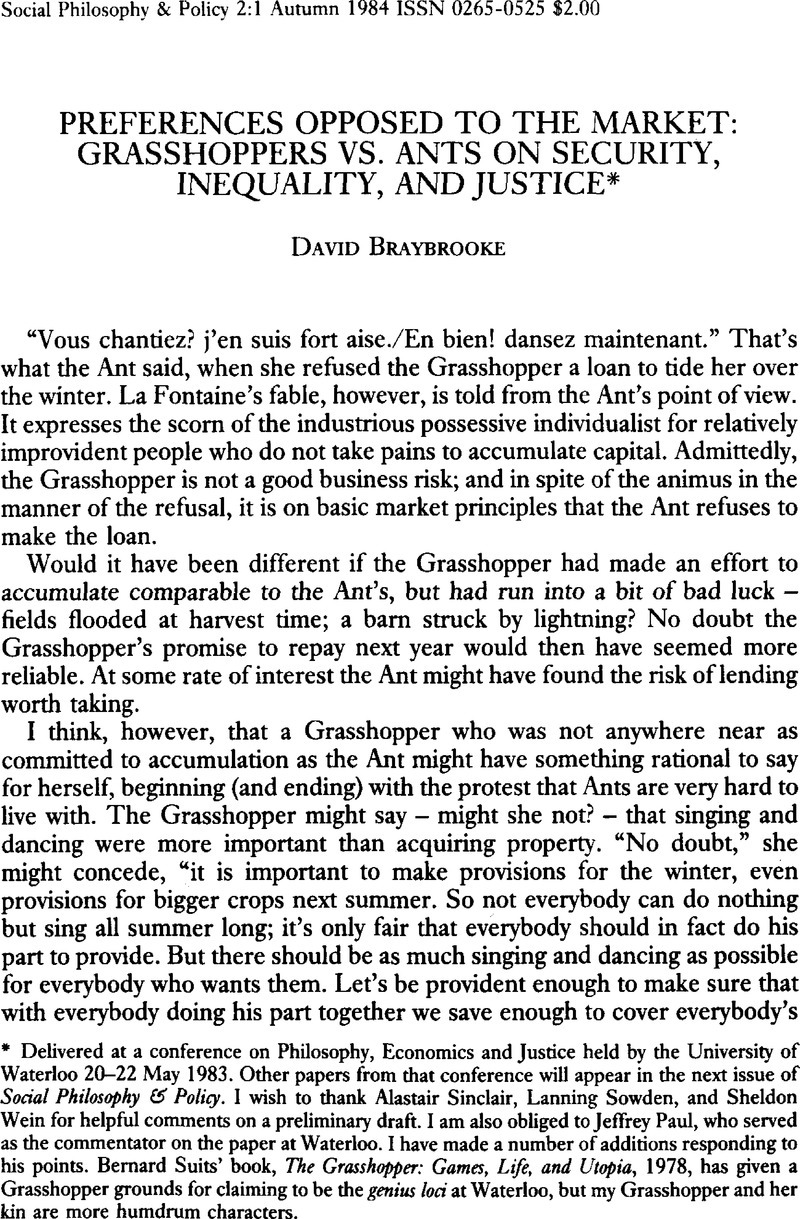No CrossRef data available.
Article contents
Preferences Opposed to the Market: Grasshoppers vs. Ants on Security, Inequality, and Justice*
Published online by Cambridge University Press: 13 January 2009
Abstract

- Type
- Research Article
- Information
- Copyright
- Copyright © Social Philosophy and Policy Foundation 1984
References
1 Gauthier, David, “Justified Inequality?,” Dialogue, 1982, 21(3), pp. 431–443CrossRefGoogle Scholar, at p. 433.
2 Nozick, Robert, Anarchy, State, and Utopia (New York: Basic Books, 1974), p. 151.Google Scholar
3 Milleron, J.-C., “Theory of Value with Public Goods,” Journal of Economic Theory, 1972, 5(3), pp. 419–77CrossRefGoogle Scholar (which draws on work by Malinvaud).
4 In this passage, I am responding to some illuminating comments by Sheldon Wein on the Grasshoppers' competitive position when the Ants acquire capital.
5 Rawls, John, A Theory of Justice (Cambridge, Ma: Harvard University Press, 1971), p. 131.Google Scholar
6 “The Ethics of Competition,” Quarterly Journal of Economics, 1923, 37, pp. 579–624; reprinted in The Ethics of Competition and Other Essays (London: Allen & Unwin, 1935).
7 This is a point that I owe to Sheldon Wein.
8 Nozick, , op cit., p. 177 ff.Google Scholar Nozick leaves the proviso otherwise indeterminate when he sets aside (p. 177) the task of relating a “base line” to “original appropriation” (itself a dubious notion).
9 An American general, in the course of defending the pacification, estimated 616,000 dead in Luzon alone – one-sixth of the population – by May 1901 ( Schirmer, Daniel B., Republic or Empire, 1972, p. 231Google Scholar). This estimate has appeared exaggerated to others, including some severe critics of the pacification. Wolff, Leon, in Little Brown Brother, 1961Google Scholar, sclaims 250,000 dead all told, including 16,000 counted as killed in action by the United States army, plus 20,000 killed but not counted, plus 200,000 civilians dead of famine and pestilence.
10 Hobbes, Thomas, Leviathan, 1651, Chap. 14.Google Scholar
11 Thurow, Lester C., Generating Inequality (New York: Basic Books, 1975), pp. 149–154.CrossRefGoogle Scholar
12 Buchanan, James M. and Tullock, Gordon, The Calculus of Consent (Ann Arbor: University of Michigan Press, 1962), pp. 192–193.CrossRefGoogle Scholar


